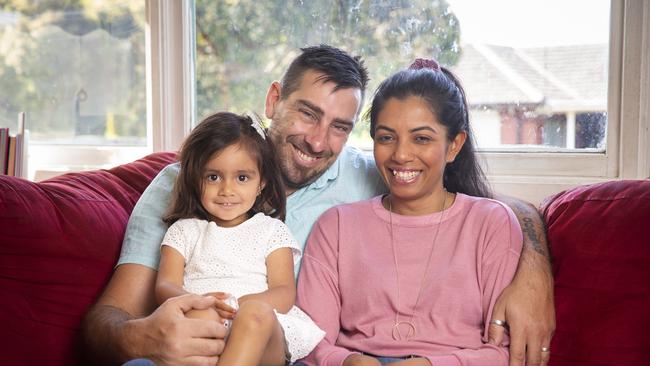Buy now pay later schemes and credit cards compared
Many Australians are shifting from credit cards to buy now pay later schemes however they can both leave you in serious financial trouble.
Business
Don't miss out on the headlines from Business. Followed categories will be added to My News.
The boom in buy now pay later schemes has seen many consumers ditch their credit cards in 2020 and join this latest payment craze.
Millions of Australians have shopped up a storm this year via their computers, tablets and smartphones and are preferring to pay off their goods in instalments instead of whacking the full amount on plastic.
Latest figures from the Australian Securities and Investments Commission showed in the 2017-18 financial year there were 16.8 million buy now pay later (BNPL) transactions.
This climbed to 32 million in the 2018-19 financial year – an increase of 90 per cent.
So for shoppers trying to decipher what’s best – BNPL or credit cards – we’ve asked the experts.
APPLICATIONS
Often when shoppers want credit they want it fast.
Financial comparison website RateCity’s spokeswoman Sally Tindall said this is where BNPL wins because it has a quicker and easier process to get the tick of approval to start shopping almost immediately.
“One of the biggest appeals of platforms such as Afterpay is there’s no complicated sign up process and no credit checks,” she said.

“In less than two minutes with little more than a few personal details you’re usually on your way.”
Lenders who offer credit cards must abide by legislation and complete rigorous checking including examining your credit file to ensure the borrower has the ability to pay back the debt.
“Credit card companies are bound by law to complete a comprehensive credit check on new customers and will typically look at how much you get paid, what other debts you have and your expenditure,” Ms Tindall said.
LIMITS
Most BNPL schemes have much smaller credit limits than credit cards.
This allows them to put up barriers to stop customers racking up a mountain of debt.
BNPL scheme Afterpay’s head of operations Melissa Bull said “customers always start on low limits and only increase with repeated positive repayment behaviour”.
“For those customers who demonstrate consistent positive repayment behaviours they can only ever have $2000 outstanding at a time,” she said.
Credit cards usually have much higher limits – RateCity’s database shows the average credit card limit is $10,000.
Of course this depends on the limit the lender is willing to give the cardholder when they apply for a card.
Debt collection agency Prushka’s chief executive officer Roger Mendelson said for customers who default on BNPL payments, “you can’t buy more”.
“They are relying on people complying and staying on top of payments so they can buy more,” he said.
FEES
The amount customers shell out in fees depends on which BNPL or credit card offer they sign up to and what rules apply.
Afterpay has no sign up or account-keeping fees, but a $10 late fee applies is if a payment is due but not received after a late payment reminder is sent by Afterpay and not paid by 11pm the following day.
A further $7 late fee applies seven days after the payment is due if the payment is still unpaid.
Rival scheme ZipPay has no fees in the first billing cycle and minimum repayments start from $40 per month.
There is a $6 monthly fee but this is waived if there is no balance.
A late fee of $5 will be charged if the repayment is overdue by 21 days.
Some credit cards have no annual fees, while cards with more bells and whistles such as rewards points often come with hefty annual fees of hundreds of dollars a year.
TROUBLE PAYING DEBT
ASIC’s report into BNPL found one in five customers are missing their scheduled payments and this has been a big money spinner for the schemes.
They raked in more than $43 million in missed payment fee revenue in the 2018-19 financial year – an increase of 38 per cent compared to the previous financial year.
Mother-of-one Lakshana Ryan, 33, from Mulgrave in Melbourne’s southeast opened up an Afterpay account last year while on maternity leave and quickly racked up debts.
“We were strapped for cash so we went on Afterpay but it became hard to make their repayments so I rang them up to get help,” she said.
“I bought a Samsung tablet and some jewellery, you name it and I had it on Afterpay with a limit of $2000. I had a balance of about $800.
“The payments were about $100 every fortnight but when I had all my bills it made it difficult.”

Earlier this year she paid off her Afterpay balance, closed her account and now sticks to paying by debit.
She also had a $2000 credit card debt which she says she was "going overboard” with and she has also paid that off and gotten rid of it.
“We are learning to now spend within our means and it’s good not to have a debt,” Ms Ryan said.
“My honest truth is don't do Afterpay. If you don’t have $50 to spend at that moment in time you don’t have that $50, it’s signing up to debt.”`
RateCity’s Ms Tindall said one of the biggest differences between BNPL and credit cards is schemes like Afterpay “ask you to pay the money back in full and relatively quickly”.
“Most credit cards are the polar opposite,” she said.
“They never ask customers to pay the balance in full – just the minimum which is usually two or three per cent of the balance outstanding,” she said.
CREDIT RATING
For many consumers they don’t realise the damage that can be done by not meeting repayments on different types of credit until it’s too late.
When applying for other types of credit such as a mortgage, car loan or personal loan, black marks can be left on a customer’s credit file.
Free credit score site Credit Simple’s general manager Michael Yates said there's “very little consistency” across the BNPL market when it comes to checks and balances and whether a missed payment will appear on a person’s credit file.
“At this point some BNPL providers may perform a credit inquiry when consumers sign up to their service, but many others won’t,” he said.
“A BNPL provider may record a late payment or default on your credit file, but again, not all of them will do this.”
Mr Yates said for credit card customers who do have a positive repayment history, this “will show on your credit file and increase your overall score”.
To check your credit file for free visit creditsimple.com.au.
FAST FACTS
BUY NOW PAY LATER
• 6.1 million approved BNPL at June 30, 2019
• 3.7 million active accounts
• 56,000 merchants using the schemes
• Most popular schemes include Afterpay, ZipPay, Humm, BrightePay, Openpay and Payright
CREDIT CARDS
• 12.9 million credit cards at October, 2020
• Total balances accruing interest at $19.7 billion, the lowest level in 16 years
• 732,000 credit card accounts have closed since March
• $7.2 billion in debt paid off since March
Sources: RBA and ASIC





